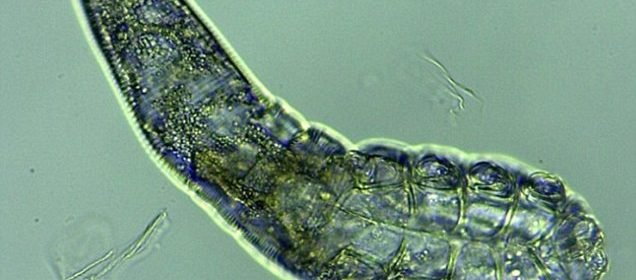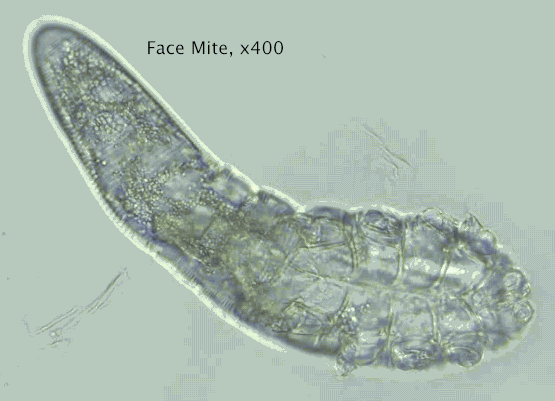Your face is teeming with mites: 8-legged mites feast on our skin oils

Your face and nipples are teeming with mites: Tiny eight-legged creatures feast on our skin oils and mate while we sleep
- Mites known as Demodex folliculorum, live near hair follicles, including the invisible hair on nipples and faces
- They are related to the spider family and measure a third of a millimeter
- We pick up eyelash mites by direct facial contact with other people
- For most people they are harmless but can cause skin complain rosacea
Your face and nipples are teeming with mites.
Demodex, as they are called, are tiny creates that live near hair follicles – including the fine, invisible facial and nipple hair on all of us.
They feed off the oils on your skin and mate while you sleep.
A microscopic gif gives a visceral idea of how these bugs spend their time on your face: wriggling their eight legs and puckering its ‘mouth’, through which it ingests oils and skin cells.
You will rarely see symptoms of your ‘demodex infestation’, but they can be a contributing factor to skin issues like acne.
We pick up eyelash mites by direct facial contact with other people – and they seem to prefer older hosts because they tend to have more oily skin.
The face mite species, known as Demodex folliculorum, exist in human ears, eyebrows, and eyelashes as well as hairs that cover nipples and genitals.
A typical eyelash mite will live for between two and three weeks.
WHAT ARE FACE MITES?
Dubbed ‘face mites,’ D. folliculorum are actually tiny arachnids that inhabit hairs throughout the human body and consume skin cells and oils.
Mites exist in human ears, eyebrows, and eyelashes as well as hairs that cover nipples and genitals.
For most people, mites are harmless.
For some, however, mites can be associated with various skin and eye disorders including rosacea and blepharitis.
Demodex have likely been living with us for a long time; as early humans walked out of Africa and found their way around the globe, the researchers say.
They found that mites from China are genetically distinct from mites from the Americas. East Asians and European populations diverged over 40,000 years ago and so far it looks like their mites did as well.
In that time, the female of the species lays about 15 to 20 eggs inside the hair follicle near the sebaceous glands.
These eggs develop into larvae, which grow into an eight-legged adult. Depending on their gender, the female stays in one location while the male will leave the hair follicle in search of a mate.
But even then, they don’t go far. They can only walk about 10mm and tend to more lively at night time.
While nothing more than an unpleasant thought for most people, the mites can be associated with various skin and eye disorders including rosacea and blepharitis.
When it dies, the creature releases a bacteria, bacillus bacterium, which triggers inflammation in patients who have rosacea, leading to the most severe form of the condition, papulopustular rosacea.
Rosacea is a genetic condition suffered by around one in ten people and usually appears after the age of 30.
It causes blood vessels in the face to dilate, causing redness and uncontrollable flushing but can also lead to red, painful, pus-filled spots which look like severe acne.
Other patients who suffer from an infestation of mites may complain of eyelid and eyebrow itching, particularly when they first wake up.
But for most of us, not being able to see the tiny critters will be enough to let us blink away their existence.
Demodex folliculorum, exist in human ears, eyebrows, and eyelashes as well as hairs that cover nipples and genitals. A recent study found them in the eyelashes of all those tested
Source: Read Full Article

